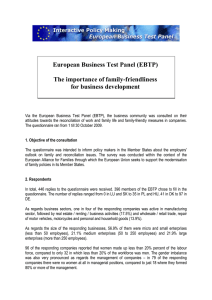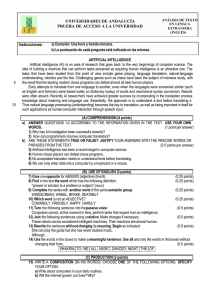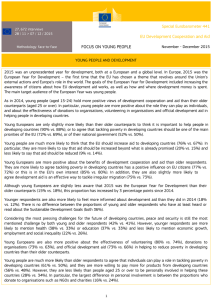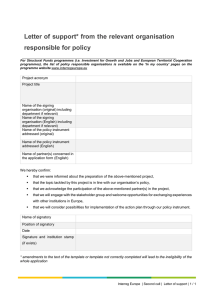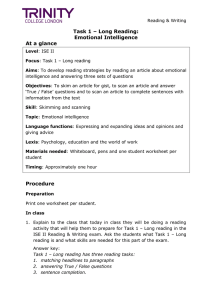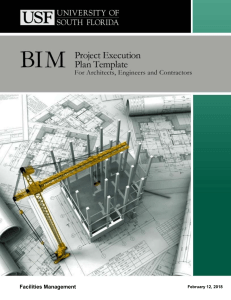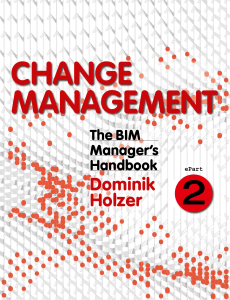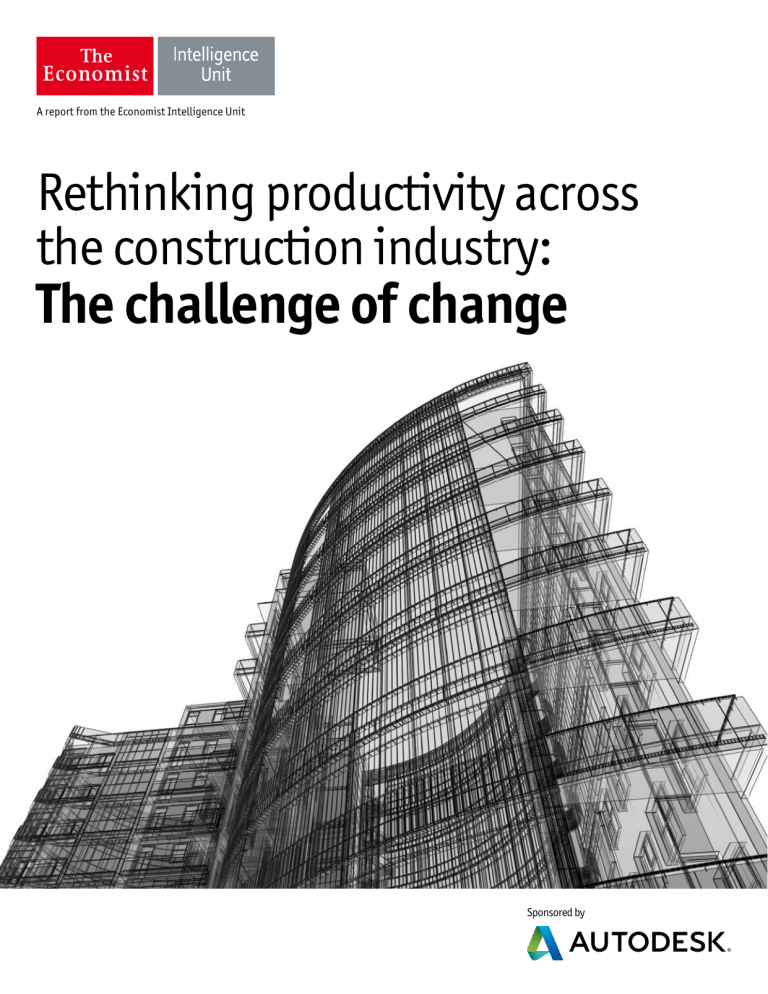
A report from the Economist Intelligence Unit Rethinking productivity across the construction industry: The challenge of change Sponsored by Rethinking productivity across the construction industry Contents 1 About this report 2 Introduction 3 1 Productivity: An industry-wide problem, with roots across the stakeholder community 4 2 New technology brings advantages and opportunities 7 3 Collaboration drives productivity 10 Conclusion 12 Appendix: Survey results 13 © The Economist Intelligence Unit Limited 2015 Rethinking productivity across the construction industry About this report Rethinking productivity across the construction industry: The challenge of change is an Economist Intelligence Unit (EIU) report, sponsored by Autodesk. In this study, the EIU provides its perspective on the causes of the current productivity gap in the global construction industry and on the tools and strategies that leading companies are adopting to address and overcome these issues around the world. To shed light on this topic, the EIU surveyed 250 global construction-industry professionals in November-December 2014. Among the study’s respondents, 28% are based in North America, 26% in Asia-Pacific and 24% in Western Europe. They hail from seven industry sectors, including residential and non-residential construction, civil and industrial infrastructure construction, architectural services, engineering services and supply-chain organisations. The respondents are all relatively senior—73% hold C-suite positions—and they work in organisations of different sizes, with 42% earning annual revenue of US$500m or more. More than half (58%) are from organisations with US$500m or less in revenue, while 23% have revenue of more than US$1bn. 2 © The Economist Intelligence Unit Limited 2015 To complement the survey findings, the EIU also conducted in-depth interviews with senior executives and industry experts. We would like to thank all survey respondents, as well as the following executives (companies listed alphabetically), for their time and insights: Michael Skelton, market strategy and business intelligence leader, AECOM Craig Halvorson, senior vice-president of operations, ARCADIS Richard Bailey, managing director of construction, BAM Construct UK Edward J Walsh, executive vice-president of energy services projects, Black & Veatch James Barrett, chief innovation officer, Turner Construction The report was written by Sarah Fister Gale and edited by Veronica Lara. Rethinking productivity across the construction industry Introduction Low productivity has been a constant drumbeat in the construction industry, raising costs and adding risk and waste across project life cycles. Efforts to improve efficiency, however, have proven difficult in a market too often defined by low margins, aggressive procurement, talent shortages and uncertain work pipelines. “Productivity is a very relevant topic right now,” says Craig Halvorson, senior vice-president of operations at ARCADIS, a Netherlands-based design and construction consultancy. The productivity problem is particularly acute on large-scale construction projects, where limited availability of talent, accelerated schedules and small or crowded job sites demand increased efficiencies in order to meet ambitious delivery goals. “The increased competition for talent, coupled with ongoing pressure from clients to be more cost competitive, is making things very intense,” Mr Halvorson says. According to Rethinking productivity across the construction industry: The challenge of change, an Economist Intelligence Unit report sponsored by Autodesk, meeting the productivity challenge continues to be an industry-wide problem. This makes it difficult for individual organisations to find solutions on their own. Improving productivity at the industry level will require changes in the 3 © The Economist Intelligence Unit Limited 2015 expectations and behaviours of all stakeholders, including clients, policymakers, and supply-chain partners as well as the contracting community itself. Improving productivity demands a prescription of collaboration that supports a culture of shared risks and rewards across the value chain and a willingness to think and act beyond the context of individual projects. Breaking down the siloes that exist between stakeholder groups and building long-term relationships that allow identification of opportunities for improvement is the first step. The situation can be further enhanced by greater adoption of value-based procurement and innovative industry technologies—such as virtual design and construction (VDC—an application used to visualise, analyse and evaluate project performance) or building information modelling (BIM—3D modelling tools for project planning and design)—as well as by minimising the impact of government regulations on individual contractors. Achieving such far-reaching, industry-wide change will take time. Yet organisations that take a leadership role in building these collaborations and harnessing technology will have an opportunity to gain a competitive advantage over their slower-moving peers and achieve a degree of insulation from the pressures of the market. Rethinking productivity across the construction industry 1 Productivity: An industry-wide problem, with roots across the stakeholder community Do you agree or disagree with the following statements about your organisation’s strategies for managing change and improving productivity? Please select one from each row. (% respondents) Agree Our senior management team recognises productivity growth to be a challenge requiring changes in expectations and behaviours of all industry stakeholders Our senior management team understands the problems associated with low productivity growth but does not have clear strategies for addressing them Disagree Don’t know/Not applicable 74 13 13 12 41 48 Source: Economist Intelligence Unit survey, November-December 2014 Leaders across the construction industry acknowledge that there is a productivity problem, which drives up risk, squeezes profit margins and limits companies’ capacity to make valuable investments (eg, in talent). Almost three out of four (74%) construction professionals surveyed say that lagging productivity is a major challenge recognised by their leadership; however, nearly half (48%) believe that their firms have failed to come up with a coherent strategy to address this problem. This is likely because the problems that cause lagging productivity tend to be industry-wide, not company-specific. Respondents rank access to skilled labour, procurement methods, government requirements and aggressive project timelines at the top of their list of productivity challenges— none of which are under the direct control of individual stakeholders. “Many of the drivers of low productivity are a result of market conditions,” says Michael Skelton, head of market strategy for AECOM, a global professional, technical and construction services firm. “It’s not just clients demanding contractors do more with less; it’s the increasing skill gaps, low construction volumes and increased competition that are forcing companies to take on projects with tight margins.” Which of the following factors present the biggest challenges to increasing productivity in your organisation? Please select up to three. (% respondents) Lack of skilled labour 35 Clients’ chosen procurement methods/contract terms 29 Requirements imposed by governments 26 Aggressive project timelines 26 Source: Economist Intelligence Unit survey, November-December 2014 4 © The Economist Intelligence Unit Limited 2015 Rethinking productivity across the construction industry ❛❛ Clients today want to get to market much quicker than they did in the past, and they want to spend the least amount of time and money on prep work. ❜❜ Richard Bailey, managing director of construction, BAM Construct UK In response, industry leaders are looking for ways to drive risk and waste from their own project-delivery process, and they see many opportunities for improvement across the range of engagements. For example, almost half of respondents (49%) say that their level of productivity in traditional design-bid-build could be substantially or moderately improved; a similar proportion (45%) believe the same level of improvements could be achieved in integrated project delivery. “Integrated project delivery and design-build contracts require a more collaborative mindset,” says James Barrett, chief innovation officer for Turner Construction, a US-based construction company. “With lump-sum contracts, there is less opportunity for collaboration.” to talent has become a major challenge for projects across the globe. “It is a risk factor that affects the success of the project,” he says. “Companies with the ability to integrate talent into seamless execution teams ultimately are positioned to deliver successful programmes and projects.” Elements of procurement, such as aggressive timelines, also add risk to individual projects, making it difficult for companies to develop long-term expertise through on-the-job training and mentoring. According to Richard Bailey, managing director of construction for BAM Construct UK, “Clients today want to get to market much quicker than they did in the past, and they want to spend the least amount of time and money on prep work.” Economy and the skills gap Driving a culture change A downturn in construction activity in 2007-12 caused many professionals to leave the industry and discouraged new workers from coming on board, leading to a multi-year skills gap. The resulting global talent shortage complicates companies’ ability to plan and staff large-scale or remotely located projects, even as the industry rebounds. A 2015 report from the UK-based Royal Institution of Chartered Surveyors (RICS) shows that the lack of skilled workers has already caused 43% of local firms to turn down new business, with estimates that this figure will rise to 45% by 2019.1 And the UK is not alone. Edward J Walsh, executive vice-president of energy services projects at Black & Veatch, a global engineering and construction company, says access Although the economy is recovering, the recession drove many clients to return to single-stage contracts and to negotiate purely on price. This differs from value-based procurement methodologies in which clients collaborate with contractors, who become involved in the planning of the project at an earlier stage, Mr Bailey explains. These had become popular in the years leading up to the recession. After 2008, the move to price-based negotiations resulted in shrinking margins and forced companies like BAM Construct UK to “go back to basics”, by reworking how they price jobs, evaluate risk and choose subcontractors to derive the most value from the project. “We had to deconstruct our entire process to look for ways to improve,” Mr Bailey says. BAM Construct isn’t alone. Many companies are 1 Alan Muse, “Will 2019 be the year that the UK stops building?” RICS, February 23rd 2015, http://www.rics.org/uk/news/news-insight/ press-releases/will-2019-be-the-year-that-the-uk-stops-building-/ To what degree could your organisation’s level of productivity be improved for each of the following types of engagements? Please rate each on a scale from “substantial room for improvement” to “no room for improvement”. (% respondents) Substantial room for improvement Moderate room for improvement Marginal room for improvement No room for improvement Do not enter into engagement Don’t know/ Not applicable Design-bid-build 16 33 24 6 8 12 Integrated project delivery (IPD) 19 26 23 7 8 17 Source: Economist Intelligence Unit survey, November-December 2014 5 © The Economist Intelligence Unit Limited 2015 Rethinking productivity across the construction industry Real change must be structural. making efforts to effect change both in their own organisations and among their stakeholders. These efforts generally centre on a combination of new tools, more efficient management practices and cross-industry collaborations to eliminate problems and ensure a focus on the same goals, Mr Barrett says. “Having better tools, technologies, and business processes enables you to improve your work.” And it seems to be working. According to survey respondents, companies implementing formal productivity efforts like those cited above are more 6 © The Economist Intelligence Unit Limited 2015 likely to rate their productivity as above average compared with their peers. Still, even these companies acknowledge that the productivity challenge has yet to be resolved. Real change must be structural. Respondents agree that a joint commitment from all stakeholder groups is required to enable greater efficiency. For example, 26% of respondents cite government requirements as a leading obstacle to productivity. Streamlining and harmonising regulations would free up resources to increase investment in talent and improve processes. Rethinking productivity across the construction industry 2 New technology brings advantages and opportunities Which of the following offer the greatest potential for improving productivity in the construction sector? Please select two. (% respondents) More rapid uptake of emerging technologies by contractors, suppliers and clients 37 Improved management practices 32 Greater adoption of value-based, collaborative procurement by clients 28 Source: Economist Intelligence Unit survey, November-December 2014 Along with improved management techniques, survey respondents view increased technology adoption as the two most effective means of solving the productivity challenge. Mobile devices are by far the most widely used tool to address productivity issues, because they enable project teams to collaborate in real time across the jobsite, to update teams on progress and to send alerts as challenges arise. However, many point to more recent innovations achieved through the use of VDC/BIM as the true industry game changers. “BIM has brought huge productivity benefits to the construction industry,” says Mr Halvorson of Netherlands-based ARCADIS. “Being able to visualise things from a 2D drawing in three dimensions gives us the ability to avoid design conflicts before construction even starts.” The benefits of VDC/BIM VDC/BIM were chosen most often by industry professionals as the technologies best positioned to boost productivity over the next three years. And one in four respondents would like to see governments incentivise technology adoption through BIM mandates. Indeed, the experts interviewed for this report cite BIM as an important innovation in the fight against lagging productivity. Turner Construction’s Mr Barrett points to how his company’s use of BIM Which technologies and management strategies do you believe can have the greatest impact on improving productivity in the construction sector over the next three years? Please select up to four. (% respondents) Virtual design and construction (VDC)/Building information modelling (BIM) 36 Online inter-organisational project collaboration tools Online training tools 33 30 Source: Economist Intelligence Unit survey, November-December 2014 7 © The Economist Intelligence Unit Limited 2015 Rethinking productivity across the construction industry ❛❛ Leading-edge technology requires investment, but it keeps us at the forefront of innovation. ❜❜ Craig Halvorson, senior vice-president of operations, ARCADIS and lean practices in the construction of Sibley Memorial Hospital in Washington, DC, shaved weeks off the construction schedule. The team used BIM to design modular prefabricated 140-ft corridor rack systems to house the mechanical, electrical and plumbing elements for each floor of the hospital. The modelling software, combined with lean methods, allowed the team to begin precisely assembling ductwork, cabling and piping at the same time that construction excavation started onsite. The 20-ft long modules were then built at a makeshift offsite factory and trucked to the job site for installation. The software allowed the construction team to ensure that the pieces would fit together without error, Mr Barrett says. “The original schedule would have required four to five weeks installation of the rack systems, but instead we completed each floor in four to five days.” Virtual design tools also enable project teams to avoid conflict and interference on the job site, which is one of the biggest inhibitors of productivity, says Mr Walsh of Black & Veatch. In traditional design methodologies, each element of a structure is created with the needs of a specific subcontractor in mind—ie, the mechanical engineering team will route pipes in a way that makes the most sense for them without considering whether their work will interfere with the electrical or other subcontracting teams. “BIM helps us resolve these issues during planning, so people aren’t running into each other in the field,” Mr Walsh says. Technology does not solve problems, people do While the use of productivity-enhancing technologies is currently widespread, it is not intensive, thus creating clear advantages for early adopters. But they have to be willing to both commit the time and the training necessary to make these tools effective, Mr Halvorson says. “Leading-edge technology requires investment, but it keeps us at the forefront of innovation.” Individual tools alone will not solve the productivity problem, however. Companies need to supplement these tools with broader business strategies to achieve the greatest efficiencies across the project life cycle, says BAM Construct UK’s Mr Bailey. This need for a combination of solutions is further reflected in the survey results, which reveal that many organisations routinely use a variety of tools and techniques to promote productivity, including VDC/BIM, online collaboration and lean management practices. How extensively has your organisation implemented the following tools and techniques for promoting productivity? (% respondents who used specified tools or techniques “routinely”) Mobile devices 75 Work order management systems 46 Online inter-organisational project collaboration tools 44 Lean management practices 44 VDC/BIM 42 Online training tools 41 Digital productivity measurement and monitoring tools 40 Enterprise resource management 40 Integrated supply chains Prefabrication/Offsite construction Logistics planning applications Alternative contracting strategies 38 35 34 33 Source: Economist Intelligence Unit survey, November-December 2014 8 © The Economist Intelligence Unit Limited 2015 Rethinking productivity across the construction industry Training is key ❛❛ If you are going to change the way you do business, you have to make a big investment in training. ❜❜ James Barrett, chief innovation officer, Turner Construction 9 Once a combination of tools and strategies is adopted, companies must invest time and resources into training everyone on the team, including clients, vendors and subcontractors. Training needs to focus on how these tools and practices work, why they add value to the project and how to make the best use of them to improve overall project outcome. Survey respondents rank online training among the top three technologies and management strategies expected to improve productivity in the next three years. They would also like to see government, industry associations and universities support more robust education programmes to develop the skills of their future workforce. Many industry companies invest heavily in their own training and mentoring programmes as soon as new recruits come on board. That just makes good business sense, says Mr Barrett: “If you are going to change the way you do business, you have to make a big investment in training.” His company’s leadership team has prioritised training © The Economist Intelligence Unit Limited 2015 of all staff to ensure that they make the best use of new technologies and project-management practices. Turner Construction also makes training part of every project kick-off meeting to ensure that subcontractors and clients understand how these tools and practices will be used, and what role each stakeholder plays in meeting project goals. “At the end of the day as the project manager we need everyone to be aligned with the project goals, including the client, or we won’t see the change we need to improve results,” he says. Training should also focus on teaching stakeholder groups how to use these tools in a more collaborative environment, says Mr Halvorson. For example, designers and scheduling engineers need to understand how to collaboratively use design and scheduling tools to share updates and provide feedback to one another, helping eliminate errors from the project process. “That combination of talent working together helps us differentiate ourselves from the competition,” Mr Halvorson says. “It is why we spend so much time and energy on training.” Rethinking productivity across the construction industry 3 Collaboration drives productivity Which of the following project partner-related obstacles present the biggest single hurdle to improving your organisation’s productivity? (% respondents) Lack of investment capital 36 Poor communication and collaboration Inadequate training resources 32 27 Source: Economist Intelligence Unit survey, November-December 2014 Indeed, the need for better collaboration among project stakeholders is a theme that runs throughout the survey responses and interviews. Online project collaboration tools rank second among the top technology and management strategies to improve productivity in the next three years. Respondents also cite poor communication and collaboration as one of the leading obstacles to partner-related productivity, underscoring the need for better partnership models between contractors, clients and investors. The success of these collaborations often depends on the participants, the projects and the willingness of leaders to make them work. Internally, collaboration between experts in different divisions is essential to ensure that the right people are available when important project opportunities arise, says Mr Halvorson. He says that his company’s commitment to collaboration helped it win a five-year, US$72m contract to manage construction of a high-speed rail project in California last year. When preparing to bid, his team identified design experts with rail experience from across the firm to help develop the proposal and meet with the client to prove that the company had the expertise to deliver the project successfully. “In a large organisation you have talent all over the place,” he says. “You want to be sure you can utilise the most qualified resources for a project— not just the ones who are most available.” High-productivity firms, as identified in the survey, are working to build stronger relationships with clients and investors so they can work more Which of the following actions by clients and investors would contribute most to improving productivity in the construction sector over the next three years? (% respondents) Willingness to engage in long-term collaborative relationships with contractors 40 Better understanding of the construction industry Greater adoption of risk-sharing contracts 36 30 Source: Economist Intelligence Unit survey, November-December 2014 10 © The Economist Intelligence Unit Limited 2015 Rethinking productivity across the construction industry ❛❛ When you have a collaborative project environment, it incentivises everyone to achieve the same outcomes and they start looking out for each other. ❜❜ Michael Skelton, market strategy and business intelligence leader, AECOM collaboratively towards identifying and meeting the quality, time and cost goals of projects. Overall, survey respondents rank willingness to collaborate with contractors as the number-one action these stakeholders can take to improve productivity. Client-focused relationships can be harder to build as they require clients to be willing to treat contractors as partners rather than vendors and to bring them into the project earlier in the process to help define goals and outcomes. The results benefit everyone, though, Mr Barrett says. When clients are knowledgeable about the project delivery process—and the benefits to the project of a variety of contract and procurement methods—they make better choices that result in fewer delays, less conflict on the job site and more cost-effective projects. “We all need to engage early in the process if we are going to overcome these productivity challenges,” he says. Government and educators also play a role in this collaborative culture. Many companies are looking to government agencies to streamline and harmonise regulations as a way to help improve productivity across the industry. They are also seeking to build stronger links with local education institutions and encouraging government investment in construction training. Share the risk, share the reward One of the greatest benefits of embracing a collaborative project culture is that every stakeholder is focused on the same set of goals, says AECOM’s Mr Skelton. He notes that in traditional construction formats, each contractor is responsible for—and paid to deliver—their piece of the project, at times without consideration of the broader project outcomes. “Without incentivising collaboration, it is likely each contractor will seek to prioritise their goals above [those of] others, even if their success leads to someone else’s failure,” he says. This often results in unnecessary conflict and delays on the job site, with different trade groups battling over the same space, tools or time to complete tasks. But all of that can be avoided if everyone on the team is working together. “When you have a collaborative project environment, it incentivises everyone to achieve the same outcomes and they start looking out for each other,” says Mr Skelton. Contractors who want clients and investors to engage in such collaborative relationships and incentive structures often have to be willing to take on more responsibility for outcomes in the form of risk-sharing contracts and financial investment in the project. “On larger projects, clients are requiring firms to take on bigger risk and even equity positions,” says Mr Halvorson. “It shifts the risk to the consultant, but it also creates opportunities for us to increase margins.” To take on such equity-sharing projects, companies must be confident in their ability to deliver quality and precision in the bidding and construction process as there is little room for error. It is a risk, but it gives the organisations that have been proactively addressing productivity issues through the adoption of better technology and management practices an edge over their peers. Firms rated by survey respondents as being the most productive place substantially more value on a greater willingness by clients to procure on an asset’s life-cycle value (30% vs 18%) and greater adoption of risk-sharing contracts (33% vs 26%). “It is a calculated risk that over time will pay off,” Mr Skelton says. “If you can maintain that competitive advantage, it will make you a market leader.” Which of the following actions by governments and educators would contribute most to improving productivity in the construction sector over the next three years? (% respondents) Government actions to streamline regulatory burden 38 Harmonisation of regulatory requirements among jurisdictions 34 Stronger links between construction sector and training institutions Government investment in construction training 31 28 Source: Economist Intelligence Unit survey, November-December 2014 11 © The Economist Intelligence Unit Limited 2015 Rethinking productivity across the construction industry Conclusion Lagging productivity in the construction sector is an ongoing challenge that worsened following the 2008 economic downturn. The solution will not be easily resolved. It requires long-term structural change through the participation of stakeholders across the industry who are willing to replace outdated methodologies and an adversarial culture with more streamlined, collaborative approaches that reward everyone for focusing on common goals. Individual firms can drive this change through the following best practices: l Adopting productivity-enhancing tools and methodologies; l Educating everyone—from in-house staff to clients, vendors and other stakeholders—on the business value that management changes bring to the project process; l Understanding that new technologies, lean management practices and more robust client relationships are each on its own only part of the solution; and 12 © The Economist Intelligence Unit Limited 2015 l Combining innovative technology with more effective business practices to eliminate wasted time and errors in the design and delivery process. “There is no single silver bullet solution for productivity,” says Mr Barrett. “Lean, BIM and collaboration are all powerful tools, but they need to be used together to deliver the most dramatically improved results.” The demand for improved productivity is not going away; if companies want to remain competitive, they have no choice but to incorporate these technologies and strategies into their project-planning and delivery process. Such commitment will ensure that clients realise the full value of their investments, while service providers who have taken a leadership role in—and driving innovation across—their supply chain will have the competitive advantage over their slower-moving peers. “The construction industry isn’t always seen as a progressive industry,” Mr Barrett says. “But we have to make changes if we want to see sustainable productivity improvements.” Rethinking productivity across the construction industry Appendix: survey results Percentages may not add to 100% owing to rounding or the ability of respondents to choose multiple responses. In your opinion, how effective is your organisation in each of the following performance indicators compared with its peers? Please rate each item on a scale from “Well above average” to “Well below average”. (% respondents) Well above average Somewhat above average Average/On par with peers Somewhat below average Well below average Don’t know/ Not applicable Profitability 13 33 Revenue growth 12 39 28 7 43 4 11 3 4 3 3 2 Productivity 14 36 Market share 10 33 25 36 11 14 8 6 Do you agree or disagree with the following statements about your organisation’s strategies for managing change and improving productivity? Please select one from each row. (% respondents) Our senior management team has recognised increasing productivity as a top priority for our organisation Our senior management team has implemented specific strategies for improving productivity within our organisation Our senior management team has advocated changes with clients and/or partners that would improve productivity for specific projects Our organisation is considered an “early adopter” of new technologies that can improve productivity Our senior management team is open to change and seriously considers stakeholder proposals for improvements Our senior management team understands the problems associated with low productivity growth but does not have clear strategies for addressing them Our senior management team recognises productivity growth to be a challenge requiring changes in expectations and behaviours of all industry stakeholders 13 © The Economist Intelligence Unit Limited 2015 Agree Disagree Don’t know/Not applicable 71 19 10 71 19 10 13 14 12 71 16 59 28 72 15 12 13 13 41 48 74 Rethinking productivity across the construction industry How extensively has your organisation implemented the following tools and techniques for promoting productivity? Please rate each item on a scale from “used routinely” to “do not use”. (% respondents) Used routinely throughout the organisation Used routinely in at least one part of the organisation Used for specific types of projects or initiatives Virtual design and construction (VDC)/Building information modelling (BIM) 22 20 Online inter-organisational project collaboration tools 19 Used on an experimental or trial basis only 18 25 Do not use Don’t know/ Not applicable 4 25 19 11 6 22 8 Online training tools 20 21 Logistics planning applications 18 25 16 Alternative contracting strategies 16 23 17 20 Enterprise resource management 22 18 17 19 21 12 8 21 12 10 20 7 10 25 Digital productivity measurement and monitoring tools 20 8 24 6 10 23 11 Integrated supply chains 19 19 18 10 21 13 Lean management practices 21 23 Prefabrication/Offsite construction 18 19 17 20 8 20 10 9 19 16 Work order management systems 24 22 22 9 14 9 Mobile devices 53 22 10 4 7 4 Which of the following factors present the biggest challenges to increasing productivity in your organisation? Please select up to three. (% respondents) Lack of skilled labour 35 Clients’ chosen procurement methods/contract terms 29 Requirements imposed by governments 26 Aggressive project timelines 26 Difficulty optimising use of internal resources 23 Lack of financial resources 23 Barriers to collaboration and information sharing with partners and suppliers 20 Poor quality of plans and specifications 17 Poor execution planning 15 Outdated technology and tools 14 Other 2 Don’t know/Not applicable 4 14 © The Economist Intelligence Unit Limited 2015 Rethinking productivity across the construction industry To what degree could your organisation’s level of productivity be improved for each of the following types of engagements? Please rate each on a scale from “substantial room for improvement” to “no room for improvement”. (% respondents) Substantial room for improvement Moderate room for improvement Marginal room for improvement No room for improvement Do not enter into engagement Don’t know/ Not applicable Design-bid-build 16 33 24 6 8 12 CM-at-risk 16 21 24 8 13 19 9 20 CM-for-fee 15 23 EPC (engineering, procurement and construction) 14 22 29 EPCM (EPC management) 17 24 27 Integrated project delivery (IPD) 19 10 7 23 26 10 5 23 16 10 7 18 8 17 Design-build 20 Public private partnership (PPP) 16 Frame contracting 9 23 28 14 22 10 20 Prime contracting 11 Delivery partner 7 10 28 24 29 10 18 10 22 8 20 10 12 26 22 10 10 20 6 22 Which technologies and management strategies do you believe can have the greatest impact on improving productivity in the construction sector over the next three years? Please select up to four. (% respondents) Virtual design and construction (VDC)/Building information modelling (BIM) 36 Online inter-organisational project collaboration tools 33 Online training tools 30 Alternative contracting strategies 26 Integrated supply chains 26 Logistics planning applications 25 Prefabrication/Offsite construction 25 Digital productivity measurement and monitoring tools 22 Lean management practices 22 Enterprise resource management 20 Mobile devices 18 Work order management systems 17 15 © The Economist Intelligence Unit Limited 2015 Rethinking productivity across the construction industry Which of the following actions by governments and educators would contribute most to improving productivity in the construction sector over the next three years? Please select up to three. (% respondents) Government actions to streamline regulatory burden 38 Harmonisation of regulatory requirements among jurisdictions 34 Stronger links between construction sector and training institutions 31 Government investment in construction training 28 Improved apprenticeship programmes 26 Government actions to incentivise technology adoption (BIM mandates) 25 Greater visibility and surety of public-sector work pipeline 25 Greater adoption of collaborative procurement methods 23 Other 1 Don’t know/Not applicable 7 Which of the following actions by clients and investors would contribute most to improving productivity in the construction sector over the next three years? Please select up to two. (% respondents) Willingness to engage in long-term collaborative relationships with contractors 40 Better understanding of the construction industry 36 Greater adoption of risk-sharing contracts 30 Greater willingness to procure on an asset’s life cycle value 24 Addressing the issue of late owner-driven changes 21 Longer product development processes 18 Other 1 Don’t know/Not applicable 6 16 © The Economist Intelligence Unit Limited 2015 Rethinking productivity across the construction industry Which of the following project partner-related obstacles present the biggest single hurdle to improving your organisation’s productivity? Please select up to three. (% respondents) Lack of investment capital 36 Poor communication and collaboration 32 Inadequate training resources 27 Lack of management skills 25 Difficulty demonstrating return on investment (ROI) on technology investments 21 Lack of senior management vision 20 Poor morale/Cohesion within project teams 20 Inadequate capacity 19 Lack of adequate technology 10 Other 2 Don’t know/Not applicable 7 Which of the following offer the greatest potential for improving productivity in the construction sector? Please select two. (% respondents) More rapid uptake of emerging technologies by contractors, suppliers and clients 37 Improved management practices 32 Greater adoption of value-based, collaborative procurement by clients 28 Streamlined/Harmonised regulatory requirements and processes 27 Action by industry associations to foster training and promulgation of best practices 26 Government action to foster training and promulgation of best practices 18 Other 0 Don’t know/Not applicable 6 17 © The Economist Intelligence Unit Limited 2015 Rethinking productivity across the construction industry Region Approximately how many people does your organisation employ? (% respondents) (% respondents) North America 28 500 or less 48 Asia-Pacific 26 501 to 1,000 20 Western Europe 24 1,001 to 5,000 15 Middle East 10 5,001 to 10,000 8 Latin America 8 10,001 to 50,000 3 Eastern Europe 4 More than 10,000 6 Africa 1 What are your organisation’s global annual revenues in US dollars? Which of the following best describes your organisation’s primary business activity? (% respondents) (% respondents) $500m or less Construction of non-residential buildings 58 26 $500m to $1bn Construction of residential buildings 18 20 $1bn to $5bn Engineering services 14 18 $5bn or more Construction of energy, natural resources or other industrial infrastructure 11 Construction supply chain partner 9 Construction of civil infrastructure (transport, utilities, etc) 8 Architectural services 8 Which of the following best describes your title? (% respondents) CEO/President/Managing director 40 CFO/Treasurer/Comptroller 18 CIO/Technology director 4 Chief investment officer 3 Other C-level executive 8 SVP/VP/Director 23 Head of business unit 0 Head of department 3 Architect 0 Engineer 1 18 © The Economist Intelligence Unit Limited 2015 9 Rethinking productivity across the construction industry Whilst every effort has been taken to verify the accuracy of this information, neither The Economist Intelligence Unit Ltd. nor the sponsor of this report can accept any responsibility or liability for reliance by any person on this white paper or any of the Cover: Shutterstock information, opinions or conclusions set out in the white paper. 19 © The Economist Intelligence Unit Limited 2015 London 20 Cabot Square London E14 4QW United Kingdom Tel: (44.20) 7576 8000 Fax: (44.20) 7576 8476 E-mail: [email protected] New York 750 Third Avenue 5th Floor New York, NY 10017 United States Tel: (1.212) 554 0600 Fax: (1.212) 586 0248 E-mail: [email protected] Hong Kong 6001, Central Plaza 18 Harbour Road Wanchai Hong Kong Tel: (852) 2585 3888 Fax: (852) 2802 7638 E-mail: [email protected] Geneva Boulevard des Tranchées 16 1206 Geneva Switzerland Tel: (41) 22 566 2470 Fax: (41) 22 346 93 47 E-mail: [email protected]
